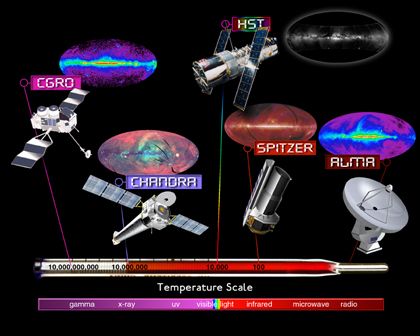Celebrating Telescopic Diversity
This week, we released a new result that combines data from Chandra with two other telescopes (MacsJ0717.) The truth is that the multiple-telescope approach is  probably no longer the exception – rather it has become the rule. Modern astronomy and astrophysics is not about being identified with one wavelength as might have been the case in the past. Instead, scientists are looking to ask questions, find answers, and see what's out there in the great big Universe. And to do that completely, they often need more than one telescope that can detect different types of light. Rather than pontificate more on this subject (which we do a lot around here), we suggest you check out some of the great material out there on multiwavelength astronomy. For example, the "Touch the Invisible Sky" book is now available as an audio podcast. Or, take a look at some of our HD podcasts, most of which give quick tours of Chandra images in context with others. And, of course, keep an eye on the website on April 16 when the newest snapshot of the cosmos gets added to our ever-expanding multiwavelength gallery.
probably no longer the exception – rather it has become the rule. Modern astronomy and astrophysics is not about being identified with one wavelength as might have been the case in the past. Instead, scientists are looking to ask questions, find answers, and see what's out there in the great big Universe. And to do that completely, they often need more than one telescope that can detect different types of light. Rather than pontificate more on this subject (which we do a lot around here), we suggest you check out some of the great material out there on multiwavelength astronomy. For example, the "Touch the Invisible Sky" book is now available as an audio podcast. Or, take a look at some of our HD podcasts, most of which give quick tours of Chandra images in context with others. And, of course, keep an eye on the website on April 16 when the newest snapshot of the cosmos gets added to our ever-expanding multiwavelength gallery.
-Megan Watzke, CXC
Please note this is a moderated blog. No pornography, spam, profanity or discriminatory remarks are allowed. No personal attacks are allowed. Users should stay on topic to keep it relevant for the readers.
Read the privacy statement
